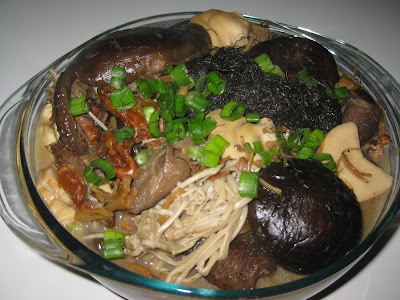Grandma used to make this on special occasions when the family gathers around for dinner, especially during Chinese New Year. Some of these ingredients are auspicious for Chinese New Year because their names in Chinese are homonym for auspicious words. To me, this is just another delicious dish grandma made. I was in charge of cooking the Chinese New Year dinner for grandma in my teenage years. I wish I could still make this for grandma.
From left to right: (Top) Dried scallops, dried oysters, shiitake mushrooms and sea cucumber. (Bottom) Fat choy, giant topshells, Pacific clams and enoki mushrooms.
The dish is called "Braised Eight Treasures" because the eight treasures are sea cucumbers, shiitake mushrooms, enoki mushrooms, dried scallops, dried oysters, giant topshells, Pacific clams and fat choy. Of course you can make this however many "treasures" you want but avoid four because it's inauspicious, although that doesn't really matter unless you have a very superstitious family. Sea cucumbers can be purchased dried or frozen. I usually just get the frozen ones because it's pre-cleaned. All you gotta do is rinse them and they are ready to be cooked.
Ingredients:
4 cups sea cucumber (cut into 2 inch pieces)
Water
3 inch ginger, bruised3 cloves garlic, bruised
2 inch ginger, bruised
3 small pieces of rock sugar (or 1 teaspoon white sugar)
2 tablespoon oil
1 tablespoon oyster sauce
1 tablespoon soy sauce
1 tablespoon sesame oil
5 cups water (or chicken stock)
4 cups soaked shiitake mushrooms (cut off the stems)
1 package of enoki mushrooms
1 cup dried scallops
1 cup dried oysters
1 can (16 oz) giant topshells
1 can (15 oz) Pacific clams
2 cups soaked fat choy
Some chopped scallions for garnishing
You should prepare the sea cucumbers first. Once you thawed the sea cucumber, wash over cold running water until water runs clear.
Drain the sea cucumber and set them aside. Discard ginger pieces.
After 30 minutes, add in dried oysters and dried scallops. Add another cup of water if it's too dry. Braise over low heat for another 30 minutes.
Then, add in sea cucumbers, giant topshells and Pacific clams. Cover and cook for 5 more minutes.
Make a small dent on the middle of the pot. Add in fat choy and cook for about 2 minutes over high heat.
Dish and sprinkle some chopped scallions on top. Serve warm.



















































